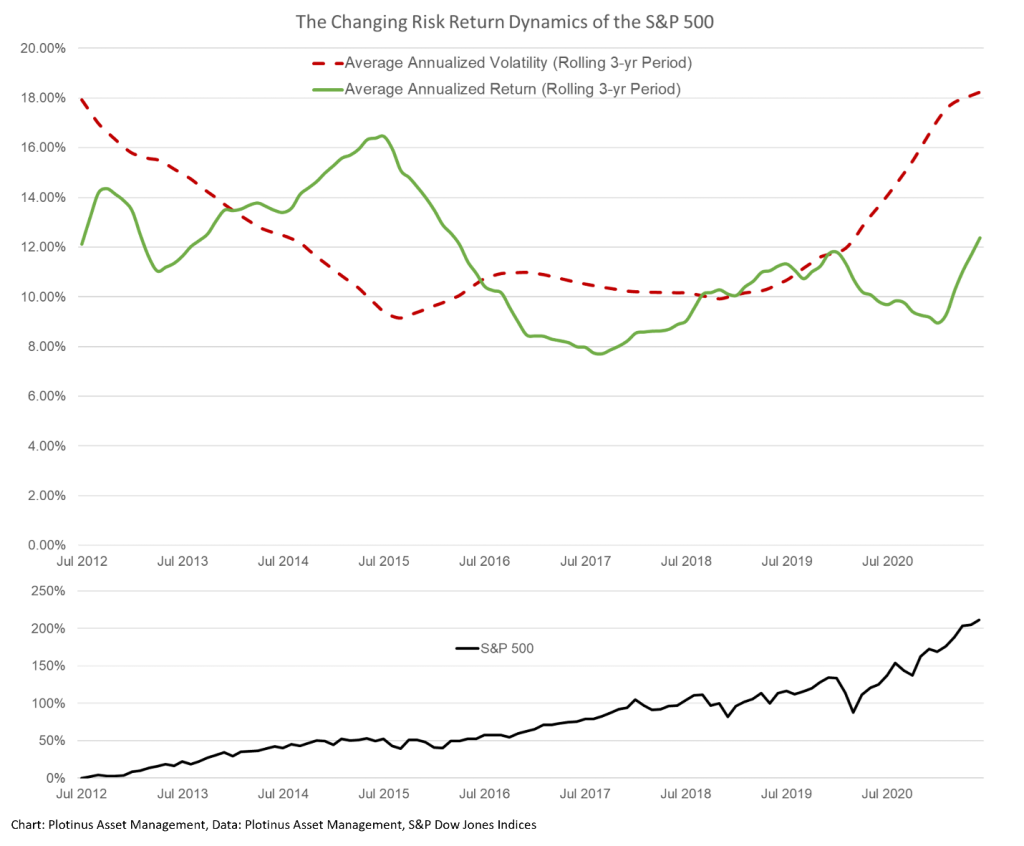Having just passed the halfway mark, 2021 thus far has been bright for US markets with the S&P 500, DJIA and NASDAQ clocking up a 14.4%, 12.7% and 12.5% return respectively for the first six months. There is, however, a lot of uncertainty as to what will happen from here until the end of the year. Experts’ and pundits’ opinions are varied with most landing in the +/- 10% range. Such a lack of consensus should not be that surprising, when one looks at risk return dynamics.

The Chart above illustrates, from one perspective, the changing relationship between the volatility and return of the S&P 500 from three years beyond the end of the pre-pandemic recession in June 2009. It looks at the 12-month average for the rolling, compound annual return and historical volatility (monthly interval) over the prior 3-year period.
It is easy to see the elevated climate of volatility since the pandemic shock of Q1 2020. Granted, in the heat of the post-pandemic roar of recovery, it was not the topic of greatest concern, but now as the outlook becomes less clear it is imperative that investors consider the potential negative implications of volatility and how best to mitigate it.
Addressing Your Equity Allocation’s Risk Exposure
The residual effect of the abnormality of the pandemic market remains an unknown. For those concerned that there is an imminent downturn ahead, assuming they call it right, the ombre of 2020’s sudden and rapid recovery makes judging the nature and duration of a downturn all the more complex. Furthermore, the struggle to find returns elsewhere, the tepid outlook for anything other than US equities, means that in the event of a downturn, equities with space to recover will remain a comparatively attractive proposition, all be it in a higher risk environment.
All of this emphasizes the importance of being able to handle downside volatility and achieve a better risk adjusted return.
So, as an investor you should want to mitigate downside volatility in your US stock market allocation in order to provide you with a better than market risk adjusted return. How are you taking action to dampen downside volatility in your portfolio now?
This is the very question that we sought to address at Plotinus several years ago as we began experimenting and building out the necessary technology to explore if an AI approach could provide a solution. Now, with a three-year live track record of success, we contend that Artificial Intelligence, if deployed correctly, offers investors a new, viable way to seek to attain this objective.
As we delved deep into the creation of specific, task-based AI to seek a better risk-adjusted returns means of having exposure to the US stock market, we made an interesting discovery. We found that a derived data approach (which our own method is based on) offers advantages over the standard big-data AI methods.
Differentiating between a derived data AI approach and a big-data AI approach, is a discussion for another day. You will be hearing more from Plotinus on this different way of thinking about, and approaching investment process construction and strategy implementation, in pursuit of risk-adjusted returns in the main asset class exposure in nearly every portfolio; that of the US stock market. ■
© 2021 Plotinus Asset Management. All rights reserved.
Unauthorized use and/or duplication of any material on this site without written permission is prohibited.
Image Credit: Iqoncept at Can Stock Photo.

